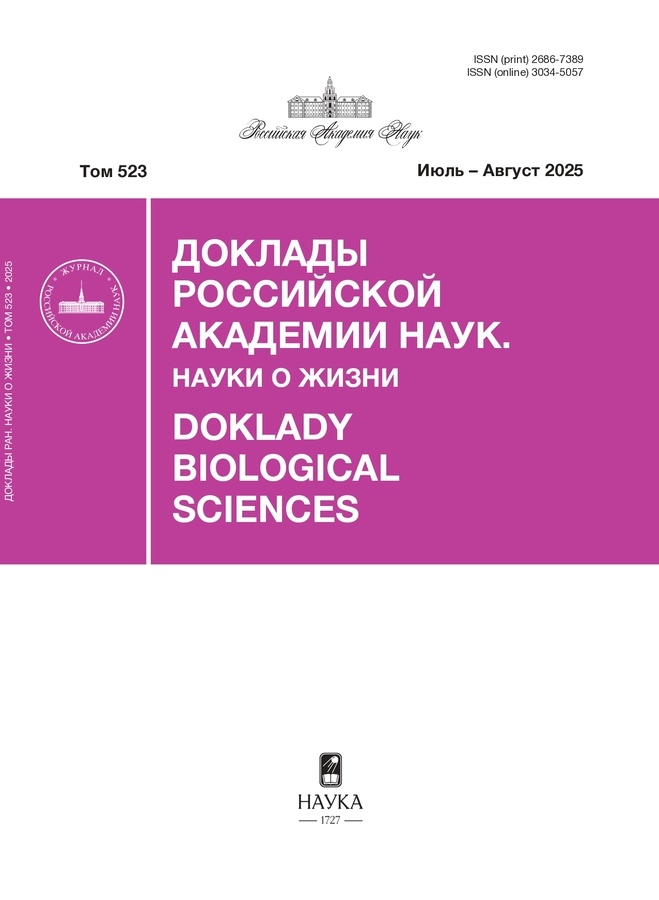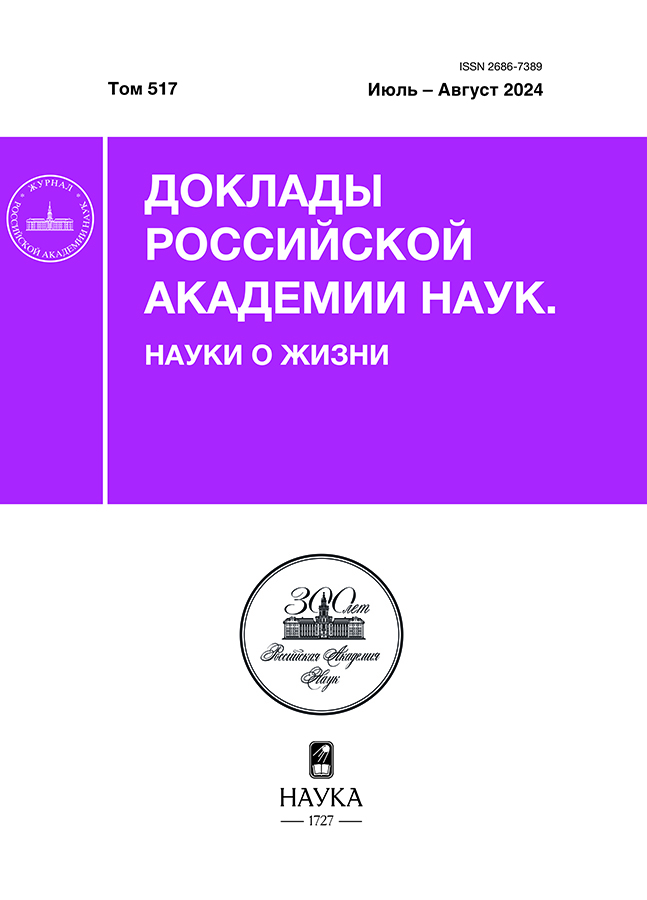Влияние взаимодействий между Su(Hw)-зависимыми инсуляторами на эффект трансвекции у Drosophila melanogaster
- Авторы: Мельникова Л.С.1, Молодина В.В.1, Георгиев П.Г.1, Головнин А.К.1
-
Учреждения:
- Федеральное государственное бюджетное учреждение науки Институт биологии гена Российской академии наук (ИБГ РАН)
- Выпуск: Том 517, № 1 (2024)
- Страницы: 61-68
- Раздел: Статьи
- URL: https://cijournal.ru/2686-7389/article/view/651418
- DOI: https://doi.org/10.31857/S2686738924040101
- ID: 651418
Цитировать
Полный текст
Аннотация
Трансвекция – явление межаллельной коммуникации, при которой энхансеры могут активировать специфичный промотор, расположенный на гомологичной хромосоме. Значительную роль в обеспечении функциональных взаимодействий между энхансерами и промоторами играют инсуляторы. В представленной работе мы смоделировали ситуацию, когда рядом с локализованными на гомологичных хромосомах энхансерами и промоторами находятся две или три копии инсулятора. На примере инсулятора Su(Hw) мы показали, что функциональное взаимодействие между парой инсуляторов способствует энхансер-промоторным транс-взаимодействиям. Взаимодействие между тремя инсуляторами, наоборот, может приводить к формированию хроматиновых петель стерически препятствующих полноценному энхансер-промоторному взаимодействию. Результаты работы позволяют предположить участие инсуляторов в регуляции гомологичного спаривания хромосом и в коммуникации между отдаленными геномными локусами.
Полный текст
Об авторах
Л. С. Мельникова
Федеральное государственное бюджетное учреждение науки Институт биологии гена Российской академии наук (ИБГ РАН)
Автор, ответственный за переписку.
Email: lsm73@mail.ru
Россия, Москва
В. В. Молодина
Федеральное государственное бюджетное учреждение науки Институт биологии гена Российской академии наук (ИБГ РАН)
Email: lsm73@mail.ru
Россия, Москва
П. Г. Георгиев
Федеральное государственное бюджетное учреждение науки Институт биологии гена Российской академии наук (ИБГ РАН)
Email: lsm73@mail.ru
академик РАН
Россия, МоскваА. К. Головнин
Федеральное государственное бюджетное учреждение науки Институт биологии гена Российской академии наук (ИБГ РАН)
Email: lsm73@mail.ru
Россия, Москва
Список литературы
- Hafner A., Boettiger A. The spatial organization of transcriptional control // Nat Rev Genet. 2023. V. 24. №1. P. 53–68.
- Kyrchanova O., Sokolov V., Georgiev P. Mechanisms of Interaction between Enhancers and Promoters in Three Drosophila Model Systems // Int J Mol Sci. 2023. V. 24. № 3. P. 2855.
- Cavalheiro G.R., Pollex T., Furlong E.E. To loop or not to loop: what is the role of TADs in enhancer function and gene regulation? // Curr Opin Genet Dev. 2021. V. 67. P. 119–129.
- Geyer P.K., Corces V.G. DNA position-specific repression of transcription by a Drosophila zinc finger protein // Genes Dev. 1992. V. 6. № 10. P. 1865–1873.
- Baxley R.M., Bullard J.D., Klein M.W., et al. Deciphering the DNA code for the function of the Drosophila polydactyl zinc finger protein Suppressor of Hairy-wing // Nucleic Acids Res. 2017. V. 45. № 8. P. 4463–4478.
- Melnikova L., Kostyuchenko M., Molodina V., et al. Interactions between BTB domain of CP190 and two adjacent regions in Su(Hw) are required for the insulator complex formation // Chromosoma. 2018. V. 127. № 1. P. 59–71.
- Golovnin A., Melnikova L., Babosha V. The N-Terminal Part of Drosophila CP190 Is a Platform for Interaction with Multiple Architectural Proteins // Int J Mol Sci. 2023. V. 24. № 21. P. 15917.
- Bartkuhn M., Straub T., Herold M., et al. Active promoters and insulators are marked by the centrosomal protein 190 // EMBO J. 2009. V. 28. № 7. P. 877–898.
- Gause M., Morcillo P., Dorsett D. Insulation of enhancer-promoter communication by a gypsy transposon insert in the Drosophila cut gene: cooperation between suppressor of hairy-wing and modifier of mdg4 proteins // Mol Cell Biol. 2001. V. 21. № 14. P. 4807–4817.
- Melnikova L., Kostyuchenko M., Molodina V., et al. Multiple interactions are involved in a highly specific association of the Mod(mdg4)-67.2 isoform with the Su(Hw) sites in Drosophila // Open Biol. 2017. V. 7. № 10. P. 170150.
- Stogios P.J., Downs G.S., Jauhal J.J.S., et al. Sequence and structural analysis of BTB domain proteins // Genome Biol. 2005. V. 6. № 10. P. R82.
- Savitskaya E., Melnikova L., Kostuchenko M., et al. Study of long-distance functional interactions between Su(Hw) insulators that can regulate enhancer-promoter communication in Drosophila melanogaster // Mol Cell Biol. 2006. V. 26. № 3. P. 754–761.
- Duncan I.W. Transvection effects in Drosophila // Annu Rev Genet. 2002. V. 36. P. 521–556.
- Kravchenko E., Savitskaya E., Kravchuk O., et al. Pairing between gypsy insulators facilitates the enhancer action in trans throughout the Drosophila genome // Mol Cell Biol. 2005. V. 25. № 21. P. 9283–9291.
- Geyer P.K., Corces V.G. Separate regulatory elements are responsible for the complex pattern of tissue-specific and developmental transcription of the yellow locus in Drosophila melanogaster // Genes Dev. 1987. V. 1. № 9. P. 996–1004.
- Qian S., Varjavand B., Pirrotta V. Molecular analysis of the zeste-white interaction reveals a promoter-proximal element essential for distant enhancer-promoter communication // Genetics. 1992. V. 131. № 1. P. 79–90.
- Geyer P.K., Spana C., Corces V.G. On the molecular mechanism of gypsy-induced mutations at the yellow locus of Drosophila melanogaster // EMBO J. 1986. V. 5. № 10. P. 2657–2662.
- Scott K.C., Taubman A.D., Geyer P.K. Enhancer blocking by the Drosophila gypsy insulator depends upon insulator anatomy and enhancer strength // Genetics. 1999. V. 153. № 2. P. 787–798.
- Bischof J., Maeda R.K., Hediger M., et al. An optimized transgenesis system for Drosophila using germ-line-specific phiC31 integrases // Proc Natl Acad Sci U S A. 2007. V. 104. № 9. P. 3312–3317.
- Baxley R.M., Soshnev A.A., Koryakov D.E., et al. The role of the Suppressor of Hairy-wing insulator protein in Drosophila oogenesis // Dev Biol. 2011. V. 356. № 2. P. 398–410.
Дополнительные файлы














